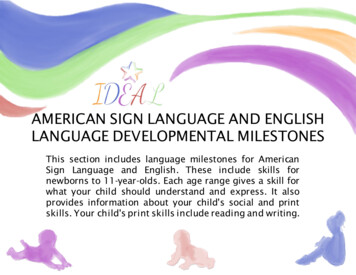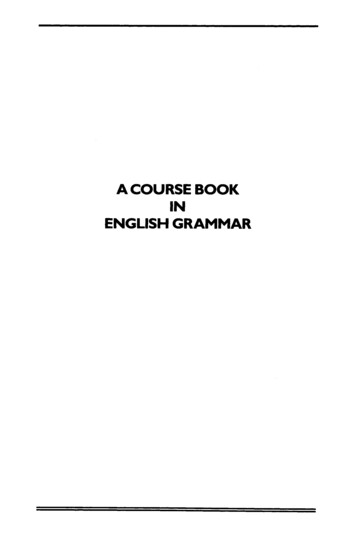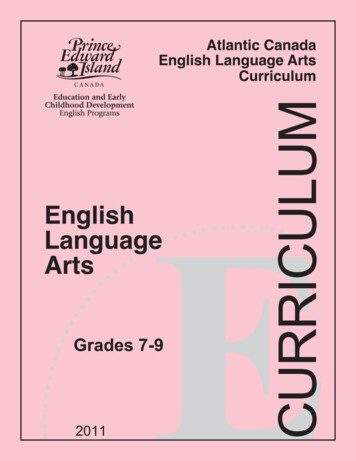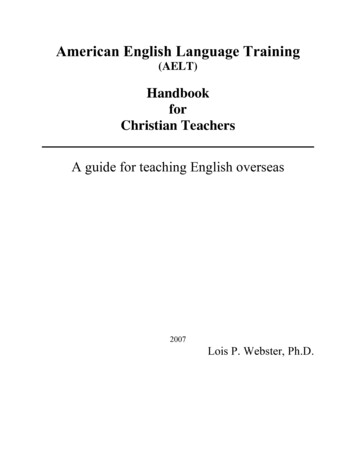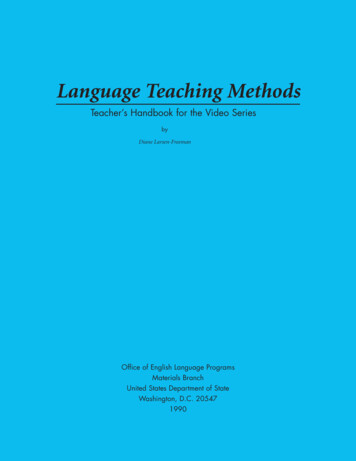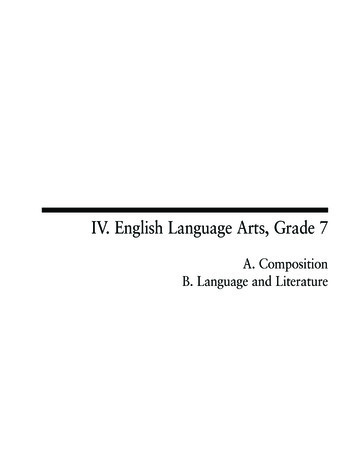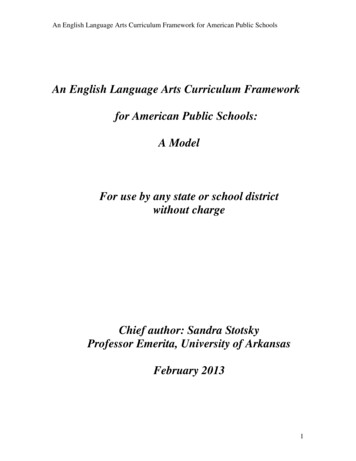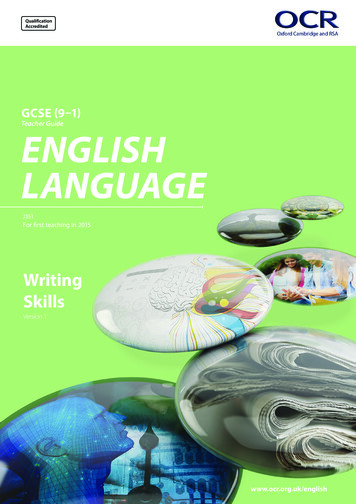
Transcription
QualificationAccreditedGCSE (9–1)Teacher GuideENGLISHLANGUAGEJ351For first teaching in 2015WritingSkillsVersion 1www.ocr.org.uk/english
GCSE (9–1) English LanguageTEACHER GUIDE: WRITING SKILLSContentsIntroduction3Writing Task Requirements4Assessment Preparation: Getting Ready to Write6Form6Content6Voice7Structure8Accurate use of language8Assessment Objectives and Level Descriptors9AO59AO611Exemplar Responses12Learner Response 112Learner Response 215Learner Response 3172Copyright OCR 2016
GCSE (9–1) English LanguageTEACHER GUIDE: WRITING SKILLSINTRODUCTIONThis guide has been produced to support teachers in their understanding of the skills that learnersare required to demonstrate in the writing sections (Section B) of the OCR GCSE English Languageexamination papers:Component 1 J351/01: Communicating information and ideasComponent 2 J351/02: Exploring effects and impactGuidance is given on the assessment requirements for the writing sections with reference to thewording of the Assessment Objectives and mark scheme level descriptors. This guide can be used inconjunction with a range of support materials already available on the GCSE (9-1) English LanguageJ351 webpage (www.ocr.org.uk/gcseenglishlanguage) including: Effective Writing skills lesson element Improving spelling, punctuation and grammar Non-fiction and creative writing skillsThe sample assessment materials for Component 1 J351/01 and Component 2 J351/02 are also referredto later in this guide.3Copyright OCR 2016
GCSE (9–1) English LanguageTEACHER GUIDE: WRITING SKILLSWRITING TASK REQUIREMENTSGCSE English Language specifications should enable learners to:The writing tasks write effectively and coherently, using Standard Englishappropriately use grammar correctly, punctuate and spell accuratelyThe assessment of writing skills is worth 50% of GCSE EnglishLanguage and so the writing section (Section B) is worth 40marks out of the total 80 marks for each component. acquire and apply a wide vocabulary, alongside a knowledgeand understanding of grammatical terminology andlinguistic conventions for writing.For each component, learners will be given a choice of twowriting tasks and they respond to one of these. This task isworth the full 40 marks for the section.In Component 1 Communicating information and ideas, learnerswill be given a choice of non-fiction writing tasks, where theform, audience and purpose of the writing will be given in thetask. In the J351/01 sample assessment materials, the choice ofwriting tasks is:In order to meet the above requirements, learners shoulddevelop the following writing skills throughout the GCSE course:Producing original texts in a variety of forms: this will includeboth non-fiction and creative writing forms. In Component 1,learners will be given a non-fiction writing task. The form thatlearners’ writing should take will be clearly given in the wordingof the task: the form will always be non-fiction and couldinclude, for example, articles, newspaper reports, speeches andletters. In Component 2, at least one writing task will be a moreopen creative writing task, where a clear form may not be given,instead learners may be asked to produce a piece of descriptivewriting, a piece of personal writing or a narrative, for example. Inthese types of tasks, learners can keep the form of their writingopen, or they are free to decide on the specific form that theirwriting will take.Write a speech for your class in which you argue thatviolence is not the solution to conflict between people. In yourspeech you should: explain why peaceful solutions are better than violent ones give some examples to support your argument convince your audience that violence does not solveconflictORProducing clear and coherent text: this involves writingeffectively for different audiences and purposes, such aswriting to describe, narrate, explain, inform, instruct, argueand persuade. Learners should think about the audience andpurpose of each writing task and try to select and adapt theirvocabulary, grammar, structural and organisational featurescarefully to reflect the audience, purpose and context. As partof this, learners will need to use language imaginatively andcreatively. They should try to maintain a consistent viewpoint intheir writing to give coherence and consistency.Write an article for a teenage magazine, which gives adviceto young people on how to cope with the pressures andstresses of modern life. You are not required to include visual orpresentational features. In your article you shouldWriting for impact: through practising different writingtechniques, learners should explore how vocabulary andgrammatical features can be used to achieve particular effects.This may include creating an emotional impact by usinglanguage creatively, imaginatively and persuasively, includingrhetorical devices, (such as rhetorical questions, antithesisand parenthesis). Learners should also develop the skills toselect, organise and emphasise key facts, ideas and pointsto pertinently support their views. Throughout the course,learners should be encouraged to apply the knowledge andunderstanding of techniques they have identified through thereading of a wide range of non-fiction and fiction texts, andrecreate these in their own writing to achieve specific effects.Over time, the writing tasks will ask learners to write in differentforms and for different purposes for a prescribed audience.4 identify some of the pressures and stresses that youngpeople face suggest why these issues may be difficult to deal with explain some of the ways they can be managedCopyright OCR 2016
GCSE (9–1) English LanguageTEACHER GUIDE: WRITING SKILLSIn Component 2 Exploring effects and impact, learners willbe given a choice of more creative writing tasks. At least onewriting task will be a more open writing task, where a clearform and/or audience may not be given. This gives learners theoption of being more imaginative in the writing they produce. Inthe J351/02 sample assessment materials, the choice of writingtasks is:Both of the Assessment Objectives for writing, AO5 and AO6,are assessed in each writing task. AO5 is concerned withthe content of the writing, the way that it is organised andstructured, and how the form, language and tone has beenadapted to suit the task, AO6 is concerned with the rangeof vocabulary and sentence structures that are used, and theaccuracy of spelling and punctuation. Out of the 40 marksavailable for the writing task in each component, 24 marks areavailable for AO5 and 16 marks are available for AO6. Furtherguidance on the writing Assessment Objectives is given later onin this guide in the ‘Assessment Objectives and Level Descriptors’section.Imagine you are writing your autobiography. Describe yourexperiences of starting a new school.You could write about: the people who made the biggest impression on you the ways in which you behaved the way you feel about those events nowORThe OutsiderLearners should consider spending about 45-50 minutes of thetwo hour exam time on the writing section; this includes thetime taken to choose the task they will respond to and to plantheir response. It is important that learners take time to carefullyread through the requirements of both tasks so that they candecide on the task which best suits them. It is equally importantthat learners plan their response before they begin writing. Thiswill help them to organise their ideas in order to make theirwriting coherent and to give it a clear structure. It also givesthem some space to consider the language techniques theymay use to meet the purpose of the task.Use this as a title for a story or piece of personal writingIn your writing you should: choose a clear viewpoint describe the setting explore what ‘being an outsider’ meansOver time, the writing tasks will ask learners to write in differentstyles which could include narratives, personal writing anddescriptive pieces. These tasks will appeal to a range of familiarexperiences, such as starting a new school, being an outsider,making choices, making a difference, childhood, courage, deceit,fear, journeys etc.Throughout the course, learners should become familiar withthe range of writing forms that they could encounter in theGCSE English Language J351 exams. They should be givenplenty of opportunity to practise writing in different styles andin different forms, for different audiences and purposes andto apply and practise the skills discussed in this guide. Widereading can also be used to develop writing skills; learnersshould be encouraged apply the understanding of linguistic andliterary methods they have gained from reading a variety of textsto inform and improve their writing.The writing tasks in both components will be loosely relatedto the theme of the reading section to provide a clear pathwaythrough the each exam paper. Each writing task will includebullet points which suggest pointers to both content and styleto make the tasks more accessible to the range of learners takingGCSE English Language.5Copyright OCR 2016
GCSE (9–1) English LanguageTEACHER GUIDE: WRITING SKILLSASSESSMENT PREPARATION: GETTING READYTO WRITEFORMWhilst the form of the non-fiction writing in Component 1 isdifferentiated and stated very clearly in the task, as mentionedabove, this may not always be the case for personal, creativewriting tasks in Component 2.Settings and characters that are exotic/ criminal /very violent/psychologically disturbed/ extra-terrestrial (to name but a few)are less likely to convince than those that are closer to home.This specification encourages learners to use wide reading toinform their writing, what is meant here is that learners willconsider what is effective in the texts they have read, and takethis on board to achieve impact in their own writing, rather thansuggesting that learners try to copy content or ideas which arenot their own.Learners’ skills to write in specific forms such as newspaper andmagazine articles, reports, speeches and many more of the like,can all be developed with the use of discrete models. Over theyears it is clear that learners can write very effectively when theyare given a specified form, audience and purpose to work with;if they want to argue a case and win the opinions of others overin their favour, for example.Learners’ responses to the creative writing tasks could be realor imagined. Learners who transpose a real experience intonarrative fiction tend to be more successful: the ‘imagined’ is aprompt suggesting ‘what if that had happened to me’ or ‘whatif that had happened within my range of experience’ so thatsomething that has been understood (for example the break-upof a friend’s family, a sibling’s success, suffering an illness) can beimagined and developed in a personal way.Personal writing is a good deal less easy to quantify. Short storiesand personal narratives that describe a range of emotions, andmake creative use of language for ‘emotional impact’ are morechallenging because they pose the questions ‘what shall I writeabout?’ and ‘where shall I go for it?’ before much thought can begiven to the form that is to be used. It can also be challenging toteach a range of narrative/descriptive forms in the abstract: sothat literary models are needed for emulation and stimulus. Theproblem then may become one of fitting the chosen contentinto a pre-conceived format, or trying to grapple with contentthat might fit a pre-selected format. For these types of writingtasks, learners need to develop a confident sense of a basic,simple and above all flexible narrative/descriptive structure,which can be readily manipulated to create linguistic effects thatflow from their preliminary response to the task.Some learners may choose to base their writing on whatthey have read in the reading section of the exam: there isno requirement to do this, nor is there a penalty for doing so,but as in the guidance above, they should try to be original intheir response. The writing tasks will be loosely based on thereading theme in order to give a clear pathway through thepapers. Learners may want to draw on the reading texts to helpgenerate ideas and techniques, but it is not intended that thewriting task is a direct extension of the reading section.In simple terms, planning for creative writing needs the stimulusand support of plenty of varied reading and thinking. Diariesand blogs can be very helpful here to help generate ideas andtechniques.CONTENTWhereas the content for non-fiction writing tasks in Component1 are more likely to be straightforward and objective: waste,homework, technology and so on, the tasks, if not theprescriptions for creative writing, make it clear thatthe content for these types of task needs tobe derived from reflection and personal,and emotional experience. For thisreason, adapting, lifting, following orcopying what others have written willoften lead to work which is unoriginal,obviously derivative and lacking a senseof freshness and creativity. Parody and satireare high order skills rarely seen at GCSE. Muchwork that is popularly read by learners is outsidethe range of their own experience and thereforetends not to translate well to their own writing.6Copyright OCR 2016
GCSE (9–1) English LanguageTEACHER GUIDE: WRITING SKILLSVOICEThis always needs careful consideration, the first of which is thatof the audience it is directed to.Many learners like to adopt a persona other than their own. Thiscan be prey to the same weaknesses of copying and derivationmentioned above, but it can be done successfully. However,it also adds a layer of extra difficulty that some learners maynot want to add in to the task and so they should considerwhether or not they will be able to keep this voice consistentand effective throughout the response. Other learners are adeptat constructing twin, overlapping narratives, which contrastnarrative voices and may be very effective.The non-fiction writing tasks will always provide an audience;the Head Teacher, a possible future employer, readers ofmagazines and newspapers, peers, parents etc.Creative writing will rarely come with a specified audiencebut the need for learners to know who they are addressing isimportant to maintain coherence and consistency. In the shortterm, the work they produce is for their teacher and perhapsa slightly wider audience of other students, teachers, siblingsand parents. In the examination that all goes: and it can beconfusing. The audience then becomes the examiner. It isimportant to see that this should be an advantage. The examinerdoes not know and will never know the learner: the work istotally anonymous and so is the centre it has been produced in.This may have (and indeed has often had) a liberating effect onlearners who are in a position to write about things they maynot have wished to share previously.The golden rules are that the narrative voice should be clear,consistent and above all confident throughout the piece.Whether the work is couched in the first person or the third,careful attention needs to be paid to the tone of voice (of thenarrator and the characters); their accent, vocabulary and pointsof view.Tone also involves mood and to an extent style. Learners oftenhave great success using irony, bathos, exaggeration, hyperbole,understatement and so on. They need to recognise that theseare all part of the narrative voice as well as the overall structure,and both need to be carefully planned before starting to write.Learners may wish to construct an audience as an integral partof their work, ‘my granddad asked me to explain.’ ‘my five yearold daughter asked me what it was like when I started school ’,‘the police sergeant looked very forbidding when I said that.’This can be a good approach so long as learners are able tosustain the voice in relation to this audience throughout theirwriting.7Copyright OCR 2016
GCSE (9–1) English LanguageTEACHER GUIDE: WRITING SKILLSSTRUCTUREACCURATE USE OF LANGUAGESome of the weakest exam writing is that which is directionlessfrom the outset or changes direction once or several times in itscourse. Some of this work may be unclear at the outset and failto reach any kind of conclusion: or vice versa.The assessment requirements for the writing tasks also focuson mechanical accuracy and ambitious use of vocabulary andsentence structures. Learners need to develop a confidentand controlled command of English syntax, grammar, spelling(particularly of commonly occurring words, both simple andcomplex), punctuation and sentence structure. To reach thehighest levels of the mark schemes, they should be able to useall those constituents to enhance their writing and give it moreof an impact.A clear sense of an overall structure and links between itsconstituent parts can enhance learners’ work significantly. Theuse of flashback, flash forward, starting at the linear conclusionand working back to the beginning, twists and surprises, canall bring a great deal of creative originality to straightforwardcontent. This will be marked by the use of paragraphs as thebuilding blocks of the overall structure. Paragraphs of variedlength, topic and linking sentences are all marks of thoughtful,well-planned work.Much can be done in a fairly straightforward way with thisaspect of writing, so long as the basics have been clearlyunderstood. For example, a change from the past to the presenttense is often effective; the use of unusual/original vocabulary,and of lists, often of synonyms and/or antonyms can enhancethe effects of learners’ writing. Varied sentence lengths and thejudicious use of direct/indirect speech and commentary alsotend to work well. The use of single sentence paragraphs canbe an effective addition, as long as learners are careful not tooverdo it.Also important is the opening of the writing. It should be onethat engages the reader and prompts them to want to read onand find out what happens next. Learners should develop theskills to create an effective opening and try to produce morethan a sentence that seems to plod through the content, storyor description. Equally as important is the conclusion: whichcan be suggested earlier in the writing, of course. The end ofthe piece is where the writer and reader have been headingfor throughout and, as stressed elsewhere, this needs to bevery carefully planned before the writing starts and remain atthe forefront of the learner’s mind as the piece develops. Thebest writing responses will always have an informing sense ofa cohering structure and overview in which the work becomesgreater than the simple sum of its parts.The best writing response will be often marked by varied,fluent, confident use of a range of grammatical and syntacticalstructures; ambitious and aptly chosen vocabulary which mayoften differentiate effects subtly; and which has been chosen tosuit and enhance what is intended, rather than to draw attentionfor its own sake.Length is an important aspect of structure. As a generalguideline, an exam essay does not need to be more than threesides of the answer booklet. Indeed much can be accomplished,including the highest marks, in less. As always, the quality of theresponse is all-important. Work of half a side or less will morethan likely penalise what the learner can be awarded as it isunlikely to include enough evidence of what the learner can doin relation to the task. On the other hand, lengthy ‘sagas’, multipart narratives, overly long descriptions, unnecessary dialogueand irrelevance should all try to be avoided. It is likely thatlearners who produce overly long pieces of work will be unableto sustain effectively all the previously mentioned elements ofwriting. Learners that produce a pithy, intense piece of writing,which is more than the sum of its parts, are more likely to reachthe higher levels of the mark scheme.8Copyright OCR 2016
GCSE (9–1) English LanguageTEACHER GUIDE: WRITING SKILLSASSESSMENT OBJECTIVES AND LEVELDESCRIPTORSAO5Communicate clearly, effectively and imaginatively, selecting and adapting tone, style and register for different forms,purposes and audiences.Organise information and ideas, using structural and grammatical features to support coherence and cohesion of texts.AO5 is assessed in both writing tasks. There are 24 marks available for AO5 in Component 1 and Component 2.For the writing tasks, there are six band levels in the mark schemes for AO5. Let’s look at the key terms in each of the leveldescriptors:Level 6: The form is deliberately1 adapted to position2 the reader,showing a sophisticated control3 of purpose and effect4. Tone, style and register are ambitiously5 selected anddeployed6 to enhance the purpose7 of the task.3Sophisticated: a synthesis of polished and accomplished; control: achievingwhat is aimed for – this is demanding and ambitious.4Reader response matches the writer’s intentions. There is a skilfully controlled overall structure, withparagraphs and grammatical features used to supportcoherence and cohesion9 and achieve particular effects.5The key word for this level.A degree of careful thought/planning, shows a deep understanding of thetask.2Enables the reader to appreciate the writer’s context and perspective.186Used effectively.7Refers to the learner’s take on the task and intentions in developing theirresponse.8The structure is deliberately (not necessarily obviously) used to suit thepurpose of the task; points build on each other and support overallcoherence; the opening and conclusion is effective. Paragraphs andgrammatical features are secure and consistent.9Consistent narrative and voice which is easily followed; the best work will begreater than the sum of its parts.12Shows a good understanding of the task.The use of tone, style and register is consistent throughout the piece andcreates an impact which suits the purpose of the task.3We lose the ‘skilfully’ here.Level 5 The form is confidently1 adapted and shows a secureunderstanding of purpose and audience. There is a sustained2 use of tone, style and register to fulfilthe purpose of the task. There is a controlled3 overall structure, with paragraphsand grammatical features used to support coherence andcohesion and achieve particular effects.9Copyright OCR 2016
GCSE (9–1) English LanguageTEACHER GUIDE: WRITING SKILLSLevel 4: The form is adapted1 to show a clear understanding ofpurpose and audience Tone, style and register are chosen to match2 the task There is a well-managed overall structure, with paragraphsand grammatical feature used, mostly securely, to supportcoherence and cohesion, and sometimes for effect.The learner’s choice form and the way it is customised and developed showsa secure understanding of the task. Note the difference here compared tothe emphasis on adaptation in the higher levels.2So that the work has consistency. The use of tone, style and register is morestraightforward.1Level 3: The form is sustained and shows clear awareness of purposeand audience. Tone, style and register is appropriate for the task, with someinconsistences. There is a clear overall structure, with paragraphs andgrammatical features used, mostly securely1, to supportcoherence and cohesion.1We’re moving away from the use of grammatical features to create impact asdescribed in the levels above.Level 2: The form, which is mostly appropriate for purpose andaudience, is generally maintained1.1 There is an attempt2 to use a tone, style and registerappropriate to the task.3Writing should still show evidence of being controlled There is some evidence of overall structure, with some useof paragraphs and grammatical features3 to supportcoherence and cohesion.1The form is identifiable but not maintainedWriting appears generally uncontrolledNarratives don’t become descriptions, arguments don’t become narratives,and so on.2These elements may not always be directed to the taskLevel 1: There is some attempt1 to use a form appropriate forpurpose and audience. There is a limited attempt to use a tone, style and registerappropriate for the task. There is some attempt to structure the response, withlimited evidence of paragraphs or grammatical features2to support coherence and cohesion.210Copyright OCR 2016
GCSE (9–1) English LanguageTEACHER GUIDE: WRITING SKILLSAO6Use a range of vocabulary and sentence structures for clarity, purpose and effect, with accurate spelling and punctuation.AO6 is assessed in both writing tasks. There are 16 marks available for AO6 in Component 1 and Component 2.AO6 encompasses four different elements: vocabulary choice, sentence structure, accurate spelling and accurate punctuation.Learners’ relative performance in all four elements will be considered when deciding on a level and mark: there is a balance to behad between ambitiousness and accuracy.For the writing tasks, there are four band levels in the mark schemes for AO6. The key terms in each of the level descriptors is givenbelow:Level 4: An ambitious range of sentence structures is used to shapemeaning and create impact1. Accurate punctuation is usedto enhance clarity and achieve particular effects2.1Vocabulary is precise and subtle3, expressing complex ideaswith clarity. Spelling of irregular and ambitious4 words isaccurate, with very occasional lapses5.2As discussed above.As discussed above.3Cleverly used for effect without being too obvious.4The key term for this level5Almost all of the writing is so clear and confident that errors do not occur.1Not necessarily for deliberate effect.Note, not simple words.Level 3: A wide range of sentence structures is used for deliberatepurpose and effect. Punctuation is consistently accurate andis used to achieve clarity 1.2Vocabulary is sometimes ambitious and used convincinglyfor purpose and effect. Spelling, including complex regularwords, is accurate; there may be occasional errors withirregular and ambitious words2.Level 2: A range of sentence structures is used, mostly securely1,and sometimes for purpose and effect. Punctuation isgenerally accurate with occasional errors.12The central question examiners will ask is ‘is the writing secure?’The writing may be clumsy and unsubtle but it’s trying to do as askedVocabulary is appropriate and shows some evidence2 ofbeing selected for deliberate effect. Spelling is generallyaccurate with occasional errors with common and morecomplex words.Level 1: Simple sentences1 are used with some attempt to use morecomplex structures. Some punctuation is used but there is alack of control and consistency2.123At Level 1, simple sentences are expected as the norm.This could include instances of no punctuation.Commonly occurring, simple words.Vocabulary is straightforward and relevant with mostlyaccurate spelling of simple3 words.11Copyright OCR 2016
GCSE (9–1) English LanguageTEACHER GUIDE: WRITING SKILLSEXEMPLAR RESPONSESBelow are some authentic learner responses to the second writing task in the sample assessment materials for Component 2Exploring effects and impact. The annotations on each script have been provided by the learners’ teacher. An examiner commentaryis also provided for each response.The task learners responded to is:The OutsiderUse this as a title for a story or piece of personal writingIn your writing you should: choose a clear viewpoint describe the setting explore what ‘being an outsider’ means[40 marks]Learner Response 1 - on page 13CommentaryAO5: Level 3AO6: Level 3This is a solid Level 3 response with some touches of individual detail and a strong and consistent, if simple and straightforwardnarrative, which push it towards but not into Level 4. The writing is reasonably secure and the vocabulary aptly chosen and varied.There is a clear and consistent first person narrative voice sustained throughout.Learner Response 2 - on page 15CommentaryAO5: Level 2/3AO6: Level 2This response is on the cusp of Levels 2 and 3. This is a straightforward anecdote, which is developed with some colourful localdetail. The narrative is less assured than the previous response and tenses are insecure. Attention has been paid to engaging thereader with an intriguing opening and narrative structure. Voice and tone are less certain.Learner Response 3 - on page 17CommentaryAO5: Level 5AO6: Level 4This is a stronger piece of writing, which adapts form confidently and has a secure voice and sense of audience. The register isclearly marked and pointed in lyrical fashion. It is coherent, cohesive, taut and concise. It is very accurate. However, it is insufficientlydeveloped for Level 6 for AO5.12Copyright OCR 2016
GCSE (9–1) English LanguageTEACHER GUIDE: WRITING SKILLSLEARNER RESPONSE 113Copyright OCR 2016
GCSE (9–1) English LanguageTEACHER GUIDE: WRITING SKILLS14Copyright OCR 2016
GCSE (9–1) English LanguageTEACHER GUIDE: WRITING SKILLSLEARNER RESPONSE 215Copyright OCR 2016
GCSE (9–1) English LanguageTEACHER GUIDE: WRITING SKILLS16Copyright OCR 2016
GCSE (9–1) English LanguageTEACHER GUIDE: WRITING SKILLSLEARNER RESPONSE 317Copyright OCR 2016
GCSE (9–1) English LanguageTEACHER GUIDE: WRITING SKILLS18Copyright OCR 2016
The small printWe’d like to know your view on the resources we produce. Byclicking on the ‘Like’ or ‘Dislike’ button you can help us to ensurethat our resources work for you. When the email template popsup please add additional comments if you wish and then just click‘Send’. Thank you.If you do not currently offer this OCR qualification but would like todo so, please complete the Expression of Interest Form which can befound here: www.ocr.org.uk/expression-of-interestOCR Resources: the small printOCR’s resources are provided to support the teaching of OCRspecifications, but in no way constitute an endorsed teachingmethod that is required by OCR. Whilst every effort is madeto ensure the accuracy of the content, OCR cannot be heldresponsible for any errors or omissions within these resources.We
understanding of techniques they have identified through the reading of a wide range of non-fiction and fiction texts, and recreate these in their own writing to achieve specific effects. The writing tasks The assessment of writing skills is worth 50% of GCSE English Language and so the



